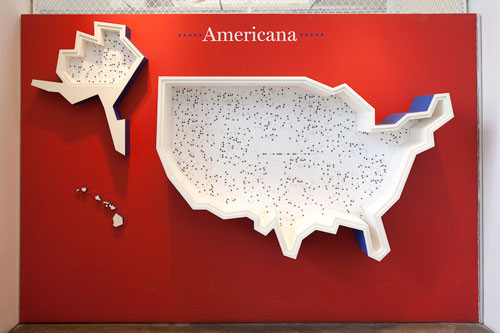Americana: New Jersey
23 Mar - 10 Apr 2010
AMERICANA: NEW JERSEY
The rhizome is an anti-genealogy.1
Mary Augustine Gallery | Mar. 23–Apr. 10, 2010
Boy meets girl. Boy and girl marry, become a family and make children. This narrative is the foundation of the American hetero-normative ideal and has been documented through pictures and the family tree. Not merely a convention of the bible and casual memory, the genealogical tree was fundamental to early sociological study. On September 15, 1906, Henry Herbert Goddard established a research laboratory at the Training School for Backward and Feeble-minded Children in Vineland, New Jersey. A follower of the popular, early twentieth-century theory of eugenics, Goddard and his associates spent two years in the New Jersey Pine Barrens scrutinizing patients, particularly resident Deborah Kallikak. In the resulting case-study, The Kallikak Family: A Study in the Heredity of Feeble-mindedness, Goddard argues that feeble-mindedness is hereditary and most often the result of "abnormal" relationships. The twenty-four arboreal family charts included use symbols, keys and lines to detail the Kallikaks: normal, feeble-minded, sexually immoral, alcoholic, insane, syphilitic, criminalistic, deaf, died in infancy and tuberculous. In Goddard's calculations, Deborah was from a long line of degenerates, all the antecedents of a single extramarital involvement. Contemporaneously Deborah's "wandering mind" would be understood as willful, crafty and imaginative rather than will-less.
Much like Goddard's reasonings, the family tree as a graphic convention is partial to life-long couplings; visually the mother and father are the origin, their offspring connect and extend. Those that marry repeat this model—coupling and procreating. The reality of human couplings exists beyond this model but how does one express aberrations and breaks in the family tree?
Reading Goddard's charts through the lens of Deleuze and Guatarri's rhizome theorized in their text A Thousand Plateaus: Capitalism and Schizophrenia allows for multiple entries: abundant, ahistorical and anti-genealogical. Brought together and layered, these charts can become anti-arboreal and form a rhizome "in the heart of a tree, the hollow of a root, the crook of a branch."2 A complex family rhizome is generated. The resulting image is expansive and illegible but reflects the complexity of human relations—from familial, to intimate, or platonic.
Curated by Jacqueline Clay
The curator would like to thank Nick Hurd, a CCA MFA student, for his help, inspiration and insight with The rhizome is an anti-genealogy.
1Gilles Deleuze and Felix Guattari, A Thousand Plateaus: Capitalism and Schizophrenia (Minneapolis: University of Minnesota, 1987), pg. 11.
2Gilles Deleuze and Felix Guattari, A Thousand Plateaus: Capitalism and Schizophrenia (Minneapolis: University of Minnesota, 1987), pg. 15.
The rhizome is an anti-genealogy.1
Mary Augustine Gallery | Mar. 23–Apr. 10, 2010
Boy meets girl. Boy and girl marry, become a family and make children. This narrative is the foundation of the American hetero-normative ideal and has been documented through pictures and the family tree. Not merely a convention of the bible and casual memory, the genealogical tree was fundamental to early sociological study. On September 15, 1906, Henry Herbert Goddard established a research laboratory at the Training School for Backward and Feeble-minded Children in Vineland, New Jersey. A follower of the popular, early twentieth-century theory of eugenics, Goddard and his associates spent two years in the New Jersey Pine Barrens scrutinizing patients, particularly resident Deborah Kallikak. In the resulting case-study, The Kallikak Family: A Study in the Heredity of Feeble-mindedness, Goddard argues that feeble-mindedness is hereditary and most often the result of "abnormal" relationships. The twenty-four arboreal family charts included use symbols, keys and lines to detail the Kallikaks: normal, feeble-minded, sexually immoral, alcoholic, insane, syphilitic, criminalistic, deaf, died in infancy and tuberculous. In Goddard's calculations, Deborah was from a long line of degenerates, all the antecedents of a single extramarital involvement. Contemporaneously Deborah's "wandering mind" would be understood as willful, crafty and imaginative rather than will-less.
Much like Goddard's reasonings, the family tree as a graphic convention is partial to life-long couplings; visually the mother and father are the origin, their offspring connect and extend. Those that marry repeat this model—coupling and procreating. The reality of human couplings exists beyond this model but how does one express aberrations and breaks in the family tree?
Reading Goddard's charts through the lens of Deleuze and Guatarri's rhizome theorized in their text A Thousand Plateaus: Capitalism and Schizophrenia allows for multiple entries: abundant, ahistorical and anti-genealogical. Brought together and layered, these charts can become anti-arboreal and form a rhizome "in the heart of a tree, the hollow of a root, the crook of a branch."2 A complex family rhizome is generated. The resulting image is expansive and illegible but reflects the complexity of human relations—from familial, to intimate, or platonic.
Curated by Jacqueline Clay
The curator would like to thank Nick Hurd, a CCA MFA student, for his help, inspiration and insight with The rhizome is an anti-genealogy.
1Gilles Deleuze and Felix Guattari, A Thousand Plateaus: Capitalism and Schizophrenia (Minneapolis: University of Minnesota, 1987), pg. 11.
2Gilles Deleuze and Felix Guattari, A Thousand Plateaus: Capitalism and Schizophrenia (Minneapolis: University of Minnesota, 1987), pg. 15.

